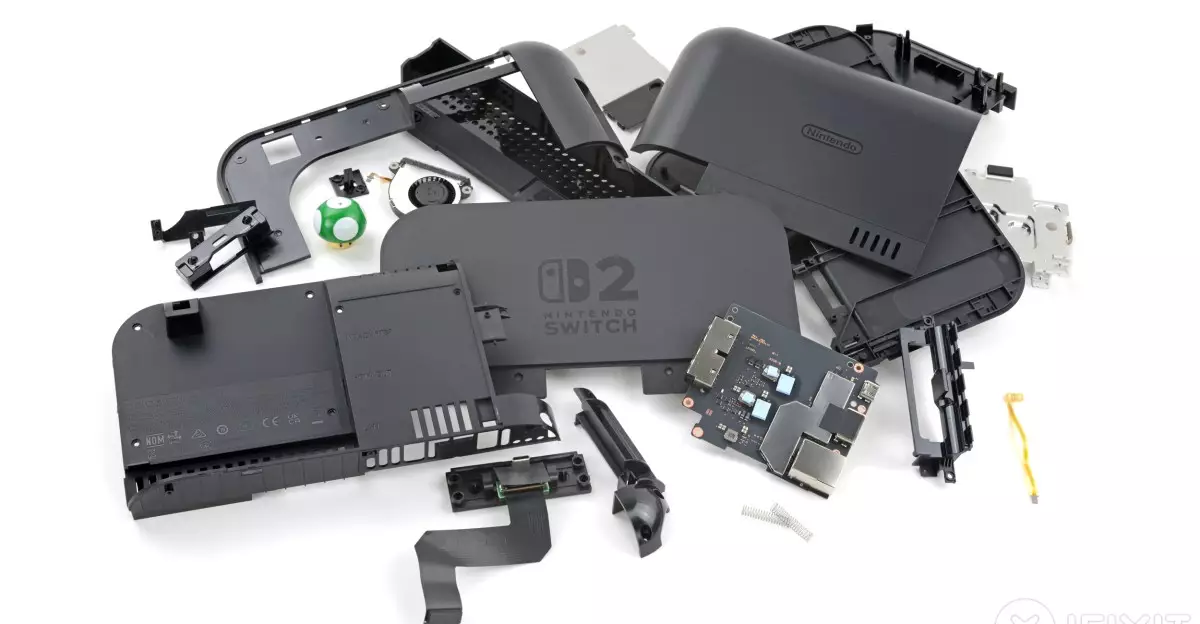Nintendo has long maintained a reputation for producing innovative and engaging gaming consoles, captivating audiences both young and old. However, with the release of the Switch 2, this iconic brand appears to be straying further from an environmentally and user-friendly approach to consumer electronics. A recent teardown by iFixit has shed light on the seemingly deliberate minimization of repairability within this new console, raising questions about Nintendo’s commitment to sustainability. With a dismal score of 3 out of 10 on iFixit’s repairability index, gamers and tech enthusiasts alike must grapple with the grim reality of a product designed for obsolescence.
The teardown reveals that essential components of the Switch 2 are now more fortified against repairs than ever before. A battery glued in with resilient adhesive, soldered storage modules, and hidden screws create a formidable barrier for anyone brave enough to attempt self-repair. Gone are the days of ease and accessibility—if anyone hoped that Switch 2 would herald a new era for repairable electronics, they are left profoundly disappointed.
The Hidden Challenges of Accessibility
Nintendo’s longstanding reliance on specific design choices—including tri-point screws—adds to the complications of servicing its devices. While these screws have served the company well for years, they now present a tangible obstacle for users hoping to take matters into their own hands. Many screws are obscured beneath stickers, which not only demand care to remove but often lead to damage in the process. This seems to point towards a design philosophy that often values aesthetic presentation over accessibility.
Moreover, Nintendo’s historical neglect of providing replacement parts and repair manuals compounds the issue. Both the original Switch and the new iteration lack the necessary support for users who want to prolong the life of their devices responsibly. Without official guidance or components, consumers are pushed towards unreliable third-party alternatives that could compromise the integrity of repairs.
In-Depth Look at Component Durability
A closer inspection of the components themselves shows that while some parts like the headphone jack and cooling fans are relatively easy to access, vital elements such as the battery and game card reader are anything but accessible. The teardown described the battery removal process as an “absolute mission,” echoing sentiments from the original Switch. Such findings highlight a troubling inconsistency within a product that should ostensibly evolve toward simpler maintenance protocols.
Adding insult to injury, the fact that many components are soldered—like the game card reader, previously a straightforward element to replace—illustrates a shift in engineering that not only complicates repairs but signals a worrying trend against user empowerments. Instead of heeding the lessons of earlier iterations, it seems Nintendo continues to prioritize compact and efficient design over user-friendly repair.
The Joy-Con Dilemma
One of the more contentious issues surrounding Nintendo products has been the notorious joystick drift problem affecting the Joy-Con controllers. Despite widespread complaints and consumer outcry, the Switch 2’s redesign showcases an unsettling decision to stick with the same potentiometer technology that led to these issues in the first place.
What’s particularly egregious is the newfound difficulty involved in repairing or replacing these joysticks. The new Joy-Cons have added layers of complexity when trying to perform what should be relatively straightforward repairs, relegating users to costly repairs or replacements through official channels. The incorporation of soldered assemblies further perpetuates a cycle of dependency on manufacturers that contradicts the very spirit of DIY repairs.
The Bigger Picture: Environment vs. Profit
In an age where sustainable practices are increasingly prioritized by consumers, Nintendo’s design choices stand in stark contrast to the pressing global calls for electronics that are easier to repair and recycle. This systemic aversion to facilitate repairs undermines not only individual users but also the environment. Instead of pursuing a path that aligns with modern expectations regarding product lifespan and repairability, Nintendo’s design ethos seems to lean more towards profit gained through planned obsolescence—a corporate mentality that should be challenged fiercely in the current climate of consumer consciousness.
As long as companies continue down this road, tech enthusiasts and environmentally conscious consumers are left at a crossroads, compelled to reconsider their investment in console gaming. Whether gamers will be willing to overlook these shortcomings remains to be seen, but for now, the future of accessible repairability within gaming equipment looks increasingly bleak.

